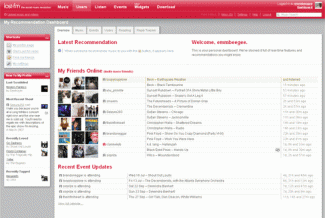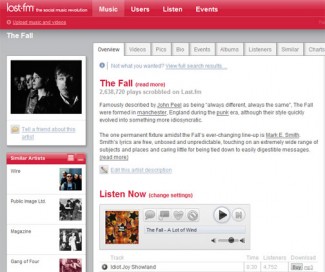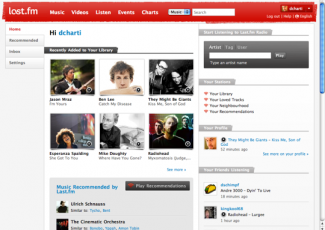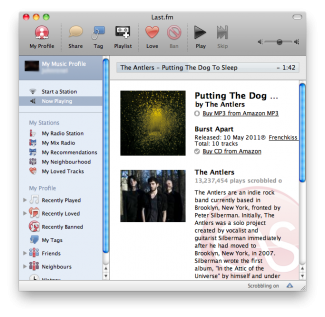DailyBean
LQ: 9.6
Recommended Age: 4+
Skills Used: Self-Awareness, Self-Control, Reading, Writing

Last.fm is a music streaming service that allows users to listen to their favorite songs, while discovering new artists through a comprehensive recommendation function called “autoscrobbler.” Last.fm builds a detailed profile of each user’s musical taste by recording details of the songs the user listens to. Users establish a library of favorite artists and genres, and can then stream music through Last.fm’s radio feature. Last.fm recommends music based on a user’s listening pattern, and provides information about the band and their current tour schedules. A mobile version is also available, allowing users to use the service on-the-go. Last.fm helps to streamline musical tastes and connect users to people with a similar taste in music. The radio service is recommended for ages 6 and up, but parents should monitor their child’s activity to ensure all songs and stations are appropriate.
Understanding our own actions, thoughts and feelings.

As your child beings to find her musical "niche," she will also be developing her cultural, social, and artistic spheres. Discovering new music is a great way to keep an open mind, and connecting with other Last.fm provides your child with a forum to discuss favorite songs and artists with other users who have similar tastes in music. It can also be a great starting point for experiencing other cultures and comparing and contrasting preferences and styles.
Adapting and adjusting to changing conditions and expectations. Trying new things.
 The purpose of services like Last.fm is to broaden musical horizons. Starting from a collection of music your child is already familiar with, she can use Last.fm's radio function to discover new songs, artists, and even entire genres that she otherwise would never have known existed. This requires a willingness to explore and experiment with unfamiliar music. Last.fm presents a simple, user-friendly interface through which to do so. Like trying a new food, new types of music may not have immediate appeal. But if your child keeps an open mind and is willing to accept an unfamiliar sound, she will be on her way to broadening her musical palate.
The purpose of services like Last.fm is to broaden musical horizons. Starting from a collection of music your child is already familiar with, she can use Last.fm's radio function to discover new songs, artists, and even entire genres that she otherwise would never have known existed. This requires a willingness to explore and experiment with unfamiliar music. Last.fm presents a simple, user-friendly interface through which to do so. Like trying a new food, new types of music may not have immediate appeal. But if your child keeps an open mind and is willing to accept an unfamiliar sound, she will be on her way to broadening her musical palate.
Arranging and coordinating materials in order to complete a task.
If your child listens to a wide range of music it is almost a given that categorizing and labeling artists and songs can become a bit of a hassle. Last.fm provides a handy organizational framework, not unlike iTunes, that allows users to maintain an orderly music collection with distinct playlists, favorites, and recommendations that can be accessed easily. Songs can be organized by "love" or "ban" icons. Your child can also tag songs by genre or theme for a further organization.
Last.fm is an excellent tool for Self-Awareness, Flexibility, and Focus. Try some of the ideas below, or suggest your own by writing in the comment field at the bottom of the page.
 Begin by helping your child create a list of her favorite songs or artists. She can create a few stations to get started, and then see what Last.fm generates. The first song your child hears will usually be from the the artist she chose. Forthcoming songs with be from related artists, resulting in a deeper exploration. She should rate each song by either "loving" or "banning" the track, and once her preferences are noted by Last.fm, the site will generate new music that it thinks she will enjoy.
Begin by helping your child create a list of her favorite songs or artists. She can create a few stations to get started, and then see what Last.fm generates. The first song your child hears will usually be from the the artist she chose. Forthcoming songs with be from related artists, resulting in a deeper exploration. She should rate each song by either "loving" or "banning" the track, and once her preferences are noted by Last.fm, the site will generate new music that it thinks she will enjoy.
Encourage your child to be open-minded in her exploration of different artists and genres. If she hears a few seconds of a song she doesn't know and immediately skips to the next, she will never be able to expand her taste in music. Use the front page of the Last.fm website to get inspiration. Click on genres or artists that seem completely unique or unfamiliar to expose your child to new types of music.
Once your child has established a good starting music library, encourage her to sort her music into various playlists. Maybe she enjoys listening to classical or ambient music when studying; devise a playlist of songs your child particularly enjoys in these genres as a go-to-schoolwork soundtrack.
 Many children who struggle with anxiety and depression find themselves “stuck” in a cycle of negative thinking. These children may struggle to alter their perceptions, think in new ways, or avoid situations which make them anxious. Last.FM helps children practice Flexibility by exposing them to unfamiliar songs and artists. The application can encourage children to practice keeping an open mind, removing them from the complacency of a familiar comfort zone. Exposure to alternative music selections can help children familiarize themselves with experiencing new and unique situations in an non-confrontational and unintimidating fashion.
Many children who struggle with anxiety and depression find themselves “stuck” in a cycle of negative thinking. These children may struggle to alter their perceptions, think in new ways, or avoid situations which make them anxious. Last.FM helps children practice Flexibility by exposing them to unfamiliar songs and artists. The application can encourage children to practice keeping an open mind, removing them from the complacency of a familiar comfort zone. Exposure to alternative music selections can help children familiarize themselves with experiencing new and unique situations in an non-confrontational and unintimidating fashion.
How to Use Last.FM for Children with Anxiety and Depression:
Last.fm is just one option for online radio. Try out the alternatives below, and let us know which one is your favorite in the comment box at the bottom of the page.
Spotify lets users stream a selection of music from a range of major and independent record labels, and organize their music by artist, album, record label, genre, or playlist. Spotify is free to use on desktop computers with advertisements, but ad-free and mobile versions require a paid subscription. Learn more here.
Pandora is a popular online radio service that allows users to stream customizable "stations" based on their musical preferences with relatively infrequent advertising breaks. Discover more here.
All membership plans come with full access to our entire suite of tools learning guides, and resources. Here are a few of the ones we think you’ll like the most: